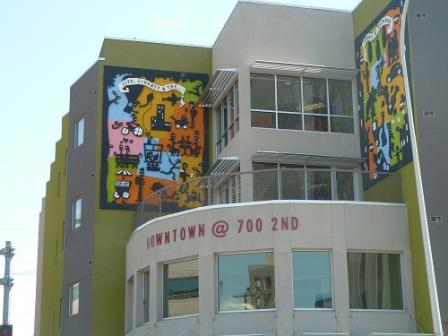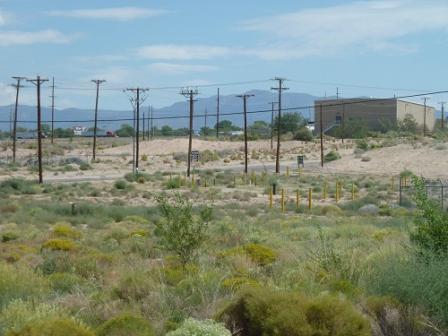Superfund Sites in Reuse in New Mexico
If you are having trouble viewing the map in your browser, click the 'View larger map' link below
Cal West Metals (USSBA)
From approximately 1961 to 1972, the Cal West Metals facility operated as a cotton gin facility. Cal West Metals also operated as a small-scale battery recycling facility and secondary lead smelter. From 1979 to 1981, the facility processed an estimated 20,000 automobile batteries to recover lead, plastics and hard rubber components for commercial sale. The owners declared bankruptcy in 1985 and Small Business Administration (SBA) foreclosed on the property. EPA placed the site on the National Priorities List (NPL) in 1989. EPA led cleanup actions at the site in 1994 and 1995. Cleanup actions included excavation, treatment and on-site disposal of approximately 45,000 cubic yards of contaminated soils, sediments and source waste materials. In 1996, the New Mexico Environment Department initiated the site’s ground water monitoring program. In December 1996, EPA deleted the site from the NPL. In 1997, the City of Socorro bought the site property. In October 2005, the City placed a restrictive covenant on the site to prevent future land use or excavation in the area of the repository cell. In September 2008, the city began leasing the site to a tenant that repairs diesel engines and heavy equipment.
For more information:
Chevron Questa Mine
 Chevron Questa MineThe Chevron Questa Mine Superfund site is located in and near the village of Questa in Taos County, New Mexico. The site includes a former molybdenum mine, milling facility and tailing impoundments. Chevron Mining Inc. (CMI), formerly Molycorp, Inc., who owns the mine and milling facility permanently ceased mining operations in June 2014. Mining operations began in 1920. From 1965 until 1983, operators conducted open pit mining, resulting in over 328 million tons of waste rock. Operators placed the waste rock into piles around the open pit. EPA placed the site on the Superfund program’s National Priorities List in September 2011. As part of the listing, EPA changed the name of the site from Molycorp, Inc. to the Chevron Questa Mine site. EPA selected the site’s remedy in December 2010. In 2012, CMI agreed to begin site cleanup. In addition to cleanup activities at the site, Chevron Technology Ventures constructed a concentrating photovoltaic (CPV) facility on a 20-acre portion of the site in 2010. The CPV facility’s 173 solar panels automatically track the path of the sun and, over the course of a year, produce about one megawatt of energy. This is about two million kilowatt hours, or roughly enough to power 150 homes. The facility has been operational since April 2011. Kit Carson Electric Cooperative is purchasing the electricity under a 20-year agreement. As of March 2013, the facility has generated about 4.6 million kilowatt hours of energy.
Chevron Questa MineThe Chevron Questa Mine Superfund site is located in and near the village of Questa in Taos County, New Mexico. The site includes a former molybdenum mine, milling facility and tailing impoundments. Chevron Mining Inc. (CMI), formerly Molycorp, Inc., who owns the mine and milling facility permanently ceased mining operations in June 2014. Mining operations began in 1920. From 1965 until 1983, operators conducted open pit mining, resulting in over 328 million tons of waste rock. Operators placed the waste rock into piles around the open pit. EPA placed the site on the Superfund program’s National Priorities List in September 2011. As part of the listing, EPA changed the name of the site from Molycorp, Inc. to the Chevron Questa Mine site. EPA selected the site’s remedy in December 2010. In 2012, CMI agreed to begin site cleanup. In addition to cleanup activities at the site, Chevron Technology Ventures constructed a concentrating photovoltaic (CPV) facility on a 20-acre portion of the site in 2010. The CPV facility’s 173 solar panels automatically track the path of the sun and, over the course of a year, produce about one megawatt of energy. This is about two million kilowatt hours, or roughly enough to power 150 homes. The facility has been operational since April 2011. Kit Carson Electric Cooperative is purchasing the electricity under a 20-year agreement. As of March 2013, the facility has generated about 4.6 million kilowatt hours of energy.
For more information:
- Redevelopment of the Molycorp Inc., Superfund Site (PDF)(1 pg, 128 K, About PDF)
- New Energies: Utility-Scale Solar on a Tailing Disposal Facility, Chevron Questa Mine Superfund Site in Questa, New Mexico (PDF)(16 pp, 6.7 MB)
- Superfund Site Profile Page
Fruit Avenue Plume
 Fruit Avenue PlumeThe Fruit Avenue Plume Superfund site consists of contaminated groundwater under part of downtown Albuquerque, New Mexico. Between 1924 and 1958, a local business owner operated Sunshine Laundry above the contaminated area. In 1940, the owner expanded his laundry services to include a dry-cleaning service, called Elite Cleaners. In April 1989, the City of Albuquerque conducted routine sampling at a nearby supply well. The City found contamination in the groundwater. Site investigators determined the historic dry-cleaning processes were the cause of groundwater contamination. EPA added the site to the Superfund program’s National Priorities List (NPL) in October 1999. The cleanup plan included soil and hot spot treatment, and groundwater restoration. Cleanup crews completed work in 2006. Collaborations between New Mexico Environment Department, EPA and a local developer helped return the site property to use as a green housing development. These new, affordable housing units exceed the baseline Green Communities Criteria. Enterprise Community Partners, Inc., a national non-profit organization, set these criteria. Green features include solar power, a water recycling system, and rooftop rainwater collection systems. The building has a large outdoor courtyard with a hands-on community garden. A hospitality center operates a coffee shop on site and also provides job training to formerly homeless community members.
Fruit Avenue PlumeThe Fruit Avenue Plume Superfund site consists of contaminated groundwater under part of downtown Albuquerque, New Mexico. Between 1924 and 1958, a local business owner operated Sunshine Laundry above the contaminated area. In 1940, the owner expanded his laundry services to include a dry-cleaning service, called Elite Cleaners. In April 1989, the City of Albuquerque conducted routine sampling at a nearby supply well. The City found contamination in the groundwater. Site investigators determined the historic dry-cleaning processes were the cause of groundwater contamination. EPA added the site to the Superfund program’s National Priorities List (NPL) in October 1999. The cleanup plan included soil and hot spot treatment, and groundwater restoration. Cleanup crews completed work in 2006. Collaborations between New Mexico Environment Department, EPA and a local developer helped return the site property to use as a green housing development. These new, affordable housing units exceed the baseline Green Communities Criteria. Enterprise Community Partners, Inc., a national non-profit organization, set these criteria. Green features include solar power, a water recycling system, and rooftop rainwater collection systems. The building has a large outdoor courtyard with a hands-on community garden. A hospitality center operates a coffee shop on site and also provides job training to formerly homeless community members.
For more information:
McGaffey and Main Groundwater Plume
The 550-acre McGaffey and Main Groundwater Plume Superfund site is located in the City of Roswell, New Mexico. From 1956 to 1976, several dry cleaning businesses operated on South Main Street. These former businesses used perchloroethene (PCE) in their daily operations. In 1994, the New Mexico Environment Department (NMED) discovered contaminants in groundwater samples. Further studies linked the contaminated groundwater to the former dry cleaning operations. NMED performed immediate cleanup actions, including connecting affected residents to the public water supply. NMED also installed groundwater monitoring wells. In September 2002, EPA added the site to the Superfund program’s National Priorities List (NPL). EPA selected a cleanup plan in 2008 to address risks from chemical vapors entering buildings through the soil. The cleanup plan also aims to restore groundwater quality to drinking water standards. To date, EPA built a system to reduce chemical vapors in buildings. EPA also built a system to remove vapors from soil and a central treatment facility. The site’s cleanup program successfully controls human exposure to remaining contamination. Land uses at the site include commercial businesses, public services, residential areas and agricultural use. Commercial and municipal uses at the former dry cleaning properties continue.
For more information:
South Valley
 South ValleyThe South Valley Superfund site is located in an industrial area of southern Albuquerque, New Mexico. The site includes two main portions: the former Air Force Plant 83 Site and the Univar Site. Beginning in the 1950s, various companies operated the two facilities located on the Air Force Plant 83 Site. General Electric Aviation took over in 1984. Parties demolished the two facilities in 1997 and 2011. Companies have used the Univar Site for various industrial and commercial purposes since the 1960s. Since 1985, Univar USA, Inc., a chemicals distribution company, has been active at the Univar Site. Studies found contamination, resulting from manufacturing practices, in soil and groundwater at the site. EPA placed the South Valley site on the Superfund program’s National Priorities List (NPL) in 1983. Cleanup actions at the former Air Force Plant 83 Site included groundwater and soil treatment. Off-site groundwater treatment and monitoring continue. All cleanup actions at the North Plant 83 and South Plant 83 areas are complete. Cleanup actions at the Univar Site include ongoing groundwater treatment. Bernalillo County has developed plans for the construction of a roadway connection between Interstate-25 and the Albuquerque airport. This roadway connection will cross the site. The County anticipates that the roadway will ease traffic and attract new businesses to the area. In 2011, after General Electric Aviation closed its jet engine component making plant on the South Plant 83 Area, the company committed to recycling or reusing all usable building materials left after demolition of the facility. This effort saved the company from sending over 14,000 tons of building materials to local landfills. It also significantly reduced demolition costs. Univar USA, Inc. continues to operate on site.
South ValleyThe South Valley Superfund site is located in an industrial area of southern Albuquerque, New Mexico. The site includes two main portions: the former Air Force Plant 83 Site and the Univar Site. Beginning in the 1950s, various companies operated the two facilities located on the Air Force Plant 83 Site. General Electric Aviation took over in 1984. Parties demolished the two facilities in 1997 and 2011. Companies have used the Univar Site for various industrial and commercial purposes since the 1960s. Since 1985, Univar USA, Inc., a chemicals distribution company, has been active at the Univar Site. Studies found contamination, resulting from manufacturing practices, in soil and groundwater at the site. EPA placed the South Valley site on the Superfund program’s National Priorities List (NPL) in 1983. Cleanup actions at the former Air Force Plant 83 Site included groundwater and soil treatment. Off-site groundwater treatment and monitoring continue. All cleanup actions at the North Plant 83 and South Plant 83 areas are complete. Cleanup actions at the Univar Site include ongoing groundwater treatment. Bernalillo County has developed plans for the construction of a roadway connection between Interstate-25 and the Albuquerque airport. This roadway connection will cross the site. The County anticipates that the roadway will ease traffic and attract new businesses to the area. In 2011, after General Electric Aviation closed its jet engine component making plant on the South Plant 83 Area, the company committed to recycling or reusing all usable building materials left after demolition of the facility. This effort saved the company from sending over 14,000 tons of building materials to local landfills. It also significantly reduced demolition costs. Univar USA, Inc. continues to operate on site.
For more information:
